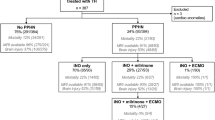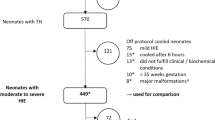Abstract
Objective:
Multiorgan dysfunction in asphyxiated newborns receiving therapeutic hypothermia achieved by either selective head cooling (SHC) or whole-body cooling (WBC) has not been well characterized. The beneficial effect of SHC in organs other than the brain may potentially be limited because unlike WBC, SHC aims to achieve effective brain cooling with less-systemic hypothermia. However, the relative effects of SHC and WBC with currently available cooling protocols on multiorgan dysfunction are unknown.The aim of this study was to compare the multiorgan dysfunction in infants receiving therapeutic hypothermia induced by either SHC or WBC.
Study Design:
In 59 asphyxiated newborns who received therapeutic hypothermia by either SHC (n=31) or WBC (n=28), the severity of pulmonary, hepatic and renal dysfunction and coagulopathy and electrolyte disturbances were assessed before the start of cooling (baseline), and at specific time intervals (24, 48 and 72 h) throughout cooling. Enrollment criteria, clinical monitoring and treatment during cooling, whether SHC or WBC, were similar, as reported earlier.
Result:
The presence of clinical respiratory distress, along with the need for ventilatory support for varying duration during cooling, was similar in both the WBC and SHC groups (100 vs 94%, P=0.49, OR 1.9, 95% CI 1.5–2.5). The use of fresh frozen plasma and platelet transfusion to treat coagulopathy and thrombocytopenia was similar (WBC 48% vs SHC 58%, P=0.59, OR 0.7, 95% CI 0.2–1.9, and WBC 41% vs SHC 32%, P=0.58, OR 1.4, 95% CI 0.5–4.2, respectively), and equivalent numbers of infants from both groups were treated with vasopressors for >24 h (WBC 59% vs SHC 55%, P=0.79, OR 1.2, 95% CI 0.4–3.4). The incidence of oliguria (urine output <0.5 ml kg–1 h–1 for >24 h after birth) and rising serum creatinine (with maximum serum creatinine >0.9 mg dl–1) was also similar (WBC 18% vs SHC 39%, P=0.15, OR 0.4, 95% CI 0.1–1.3, and WBC 48% vs SHC 58%, P=0.59, OR 0.7, 95% CI 0.2–1.9, respectively). Laboratory parameters to assess the differential effect of WBC versus SHC on multiorgan dysfunction during 72 h of cooling, which include serum transaminases (serum aspartate aminotransferase and alanine aminotransferase), prothrombin time, partial thromboplastin time, INR, platelet counts, serum creatinine, serum sodium, serum potassium and serum calcium, were similar between the groups at the initiation of cooling and did not differ with the method of cooling.
Conclusion:
Multiorgan system dysfunction in asphyxiated newborns during cooling remains similar for both cooling methods. Concerns regarding a differential effect of WBC versus SHC on multiorgan dysfunction, other than of the brain, should not be a consideration in selecting a method to produce therapeutic hypothermia.
This is a preview of subscription content, access via your institution
Access options
Subscribe to this journal
Receive 12 print issues and online access
$259.00 per year
only $21.58 per issue
Buy this article
- Purchase on Springer Link
- Instant access to full article PDF
Prices may be subject to local taxes which are calculated during checkout
Similar content being viewed by others
References
Jacobs S, Hunt R, Tarnow-Mordi W, Inder T, Davis P . Cooling for newborns with hypoxic ischaemic encephalopathy. Cochrane Database Syst Rev 2007; 4: CD003311.
Shah P, Riphagen S, Beyene J, Perlman M . Multiorgan dysfunction in infants with post-asphyxial hypoxic-ischaemic encephalopathy. Arch Dis Child Fetal Neonatal Ed 2004; 89 (2): F152–F155.
Róka A, Vásárhelyi B, Bodrogi E, Machay T, Szabó M . Changes in laboratory parameters indicating cell necrosis and organ dysfunction in asphyxiated neonates on moderate systemic hypothermia. Acta Paediatr 2007; 96: 1118–1121.
Azzopardi D, Edwards AD . Hypothermia. Semin Fetal Neonatal Med 2007; 12: 303–310.
Polin RA, Randis TM, Sahni R . Systemic hypothermia to decrease morbidity of hypoxic-ischemic brain injury. J Perinatol 2007; 27: S47–S58.
Gluckman PD, Wyatt JS, Azzopardi D, Ballard R, Edwards AD, Ferriero DM et al. Selective head cooling with mild systemic hypothermia after neonatal encephalopathy: multicentre randomised trial. Lancet 2005; 365: 663–670.
Shankaran S, Laptook AR, Ehrenkranz RA, Tyson JE, McDonald SA, Donovan EF et al. Whole-body hypothermia for neonates with hypoxic-ischemic encephalopathy. N Engl J Med 2005; 353: 1574–1584.
Martin-Ancel A, Garcia-Alix A, Gaya F, Cabanas F, Burgueros M, Quero J . Multiple organ involvement in perinatal asphyxia. J Pediatr 1995; 127 (5): 786–793.
Sarkar S, Barks JD, Bhagat I, Dechert R, Donn SM . Pulmonary dysfunction and therapeutic hypothermia in asphyxiated newborns: whole body versus selective head cooling. Am J Perinatol 2008, DOI: 10.1055/s-0028-1103154.
Gillespie LM, White SD, Sinha SK, Donn SM . Usefulness of the minute ventilation test in predicting successful extubation in newborn infants: a randomized controlled trial. J Perinatol 2003; 23: 205–207.
Thoresen M, Penrice J, Lorek A, Cady EB, Wylezinska M, Kirkbride V . Mild hypothermia after severe transient hypoxia-ischemia ameliorates delayed cerebral energy failure in the newborn piglet. Pediatr Res 1995; 37: 667–670.
Thoresen M, Satas S, Puka-Sundvall M, Whitelaw A, Hallstrom A, Loberg EM et al. Post-hypoxic hypothermia reduces cerebrocortical release of NO and excitotoxins. Neuroreport 1997; 8: 3359–3362.
Si QS, Nakamura Y, Kataoka K . Hypothermic suppression of microglial activation in culture: inhibition of cell proliferation and production of nitric oxide and superoxide. Neuroscience 1997; 81: 223–229.
Eicher DJ, Wagner CL, Katikaneni LP, Hulsey TC, Bass WT, Kaufman DA et al. Moderate hypothermia in neonatal encephalopathy: safety outcomes. Pediatr Neurol 2005; 32 (1): 18–24.
Schulzke SM, Rao S, Patole SK . A systematic review of cooling for neuroprotection in neonates with hypoxic ischemic encephalopathy—are we there yet? BMC Pediatr 2007; 7: 30.
Karlsson M, Tooley JR, Satas S, Hobbs CE, Chakkarapani E, Stone J et al. Delayed hypothermia as selective head cooling or whole body cooling does not protect brain or body in newborn pig subjected to hypoxia-ischemia. Pediatr Res 2008; 64 (1): 74–78.
Author information
Authors and Affiliations
Corresponding author
Rights and permissions
About this article
Cite this article
Sarkar, S., Barks, J., Bhagat, I. et al. Effects of therapeutic hypothermia on multiorgan dysfunction in asphyxiated newborns: whole-body cooling versus selective head cooling. J Perinatol 29, 558–563 (2009). https://doi.org/10.1038/jp.2009.37
Received:
Revised:
Accepted:
Published:
Issue Date:
DOI: https://doi.org/10.1038/jp.2009.37
Keywords
This article is cited by
-
Head cooling wrap could suppress the elevation of core temperature after cardiac surgery during forced-air warming in a pediatric intensive care unit: a randomized clinical trial
Journal of Anesthesia (2023)
-
Patterns of acute kidney and hepatic injury and association with adverse outcomes in infants undergoing therapeutic hypothermia for hypoxic ischemic encephalopathy
Journal of Perinatology (2022)
-
Hemodynamic response to milrinone for refractory hypoxemia during therapeutic hypothermia for neonatal hypoxic ischemic encephalopathy
Journal of Perinatology (2021)
-
Nephrotoxic medications and acute kidney injury risk factors in the neonatal intensive care unit: clinical challenges for neonatologists and nephrologists
Pediatric Nephrology (2020)
-
Coagulopathy in newborns with hypoxic ischemic encephalopathy (HIE) treated with therapeutic hypothermia: a retrospective case-control study
BMC Pediatrics (2014)



